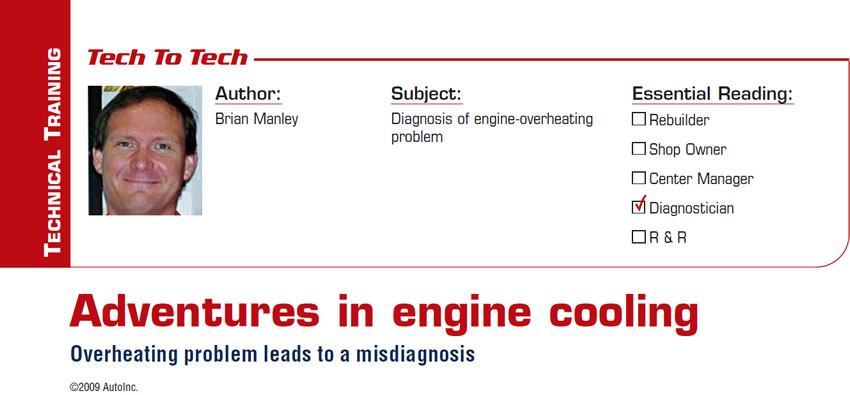
Tech to Tech
- Subject: Diagnosis of engine-overheating problem
- Essential Reading: Diagnostician
- Author: Brian Manley
Overheating problem leads to a misdiagnosis
“My car’s overheating,” said my friend on the other end of the phone.
“Bring it in,” I replied, confident of a quick diagnosis and repair.
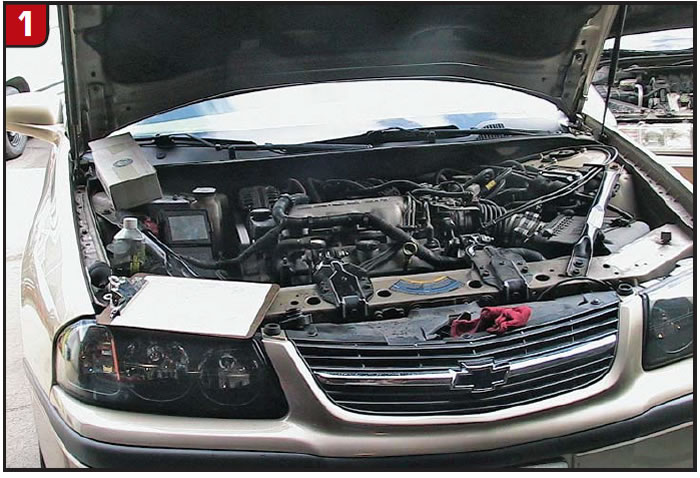
Once the car was in my bay, I popped the hood to find answers to some basic cooling-system questions: What is the coolant level in the overflow bottle and radiator? Are there any visible leaks? Will it overheat if I let it run? Does the radiator fan function?
The coolant level in the overflow was “full”; however, the level in the radiator was a half gallon low. Even after I topped off the radiator, the engine overheated after running for only 10 minutes. The cooling fan worked, and the temperature of both radiator hoses indicated that the thermostat was wide open. I wondered if there was a circulation issue such as a water pump that decided to fail, or a radiator with internal blockage. The radiator and coolant both seemed clean, and I observed flow when I peered into the radiator neck.
At this point I’m certain that many of you are yelling at me to take the next logical step and perform a combustion leak test. As I grabbed – and then dusted off – my seldom-used block tester, I wondered aloud how this 2006 vehicle with 46,000 miles could possibly have a failed head gasket. I have been around long enough to know that seemingly major failures do occur at a young age in some vehicles, and I never overlook what logical testing leads me to do.
For those of you who have never used a combustion-leak tester like the one shown, I recommend it to either confirm or deny the presence of combustion gases in the cooling system.
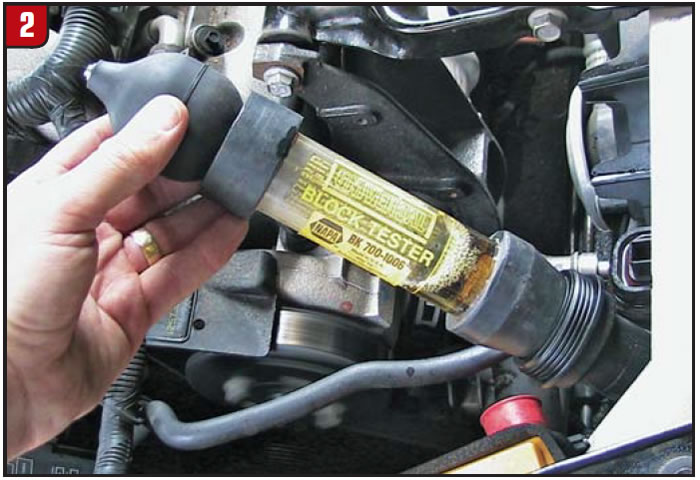
You can pick one up at some auto-parts stores, and I’ve even seen them on eBay. Before the test can be performed, the level of the coolant must be below the bottom of the tester to avoid pulling liquid up into the test fluid. I drained the coolant down in the radiator one to two inches to avoid this. I poured the special blue “test fluid” into the tester until it was even with the line near the bottom. I attached the squeeze bulb at the top of the tester, started the engine and then slowly squeezed and released the bulb to create negative pressure in the test cylinder, which will “pull” any gases from the cooling system through the test fluid. If the blue fluid turns to yellow within a minute – just as mine did – the test is positive. I had combustion gases in my coolant! I performed this test twice to make certain that I did not contaminate the fluid with coolant, and also to validate the test: two positive readings.

I wanted to confirm my diagnosis with another method, since the repair involves lots of time and money, so I rolled my old four-gas analyzer over and warmed it up. Once it calibrated and I took an ambient hydrocarbon reading from the shop, which was 0 (thank goodness), I held the probe over the neck of the radiator to find consistent readings of more than 100 parts per million! I had my confirmation.
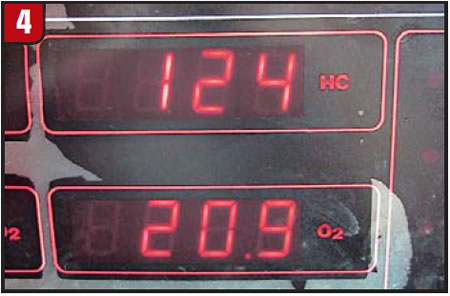
With confidence, I called my friend to tell him the hard-to-deliver news, and he headed over to pick up his car. He thought that since he had always had the service performed on his low-mileage, 2006 vehicle at the dealer, he could take it back to them and ask if there was any warranty for head-gasket failure. It seemed logical to me, and since I was waiting for him to pick up his car, I plugged in my scan tool to look for any trouble codes. I found a “P0300 Random Cylinder Misfire,” which went nicely with the misfire that I could feel in the seat of my pants.
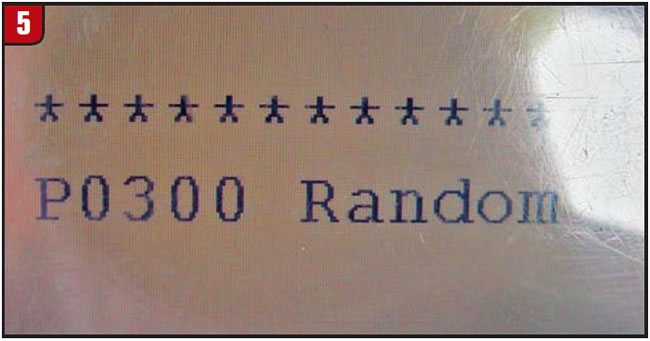
Further investigation revealed that cylinder No. 1 had contributed more than its share of misfires; undoubtedly, it was the cylinder accepting all the engine coolant. My friend took the car to his dealer the next morning, told the service writer what I had found and waited for them to call with their own diagnosis. I had all the confidence in the world that they would find the root cause, just as I had.
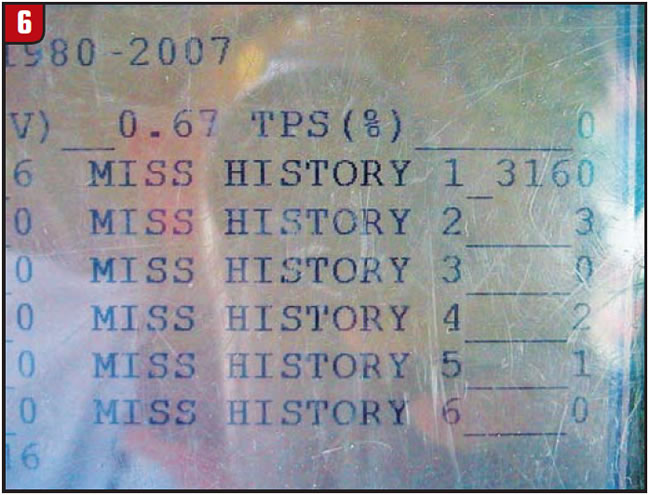
“It needs a water pump and a thermostat,” said the service manager to my friend.
Of course, when my friend told me this, I said, “?!?!?!?!?!”
It was too late for me to call the dealer, because my friend was happy to give them the go-ahead for a repair that was much less expensive than replacing the head gaskets. I assured my friend that he had better have someone follow him home from the dealer because it was going to overheat again. I even made a bet with him, but I can’t remember how much it was. Sure enough, it didn’t make it two miles from the dealer, so he took it back, and once the dealer had the correct diagnosis, my friend had them apply all the prior labor toward the head-gasket replacement.
They did not warrant the repair for the engine, even though it had been serviced at their dealership its entire life.
The moral of the story? Always confirm your diagnosis, using all the methods at your disposal, and have confidence in your ability. I have sent customers back to their dealer under similar circumstances, and the dealer has performed the repair under warranty, saving our customers hundreds of dollars. Even though I don’t get the initial repair in these situations, the goodwill I garner brings future repairs into my bay.

Brian Manley is a vocational automotive instructor for the Cherry Creek school district in Aurora, Colo. He is an ASE master certified automobile technician and a former member of the National Automotive Technicians Education Foundation (NATEF) board of trustees. You can reach him at [email protected].
This copyrighted article is reprinted with the permission of AutoInc., the official publication of the Automotive Service Association (ASA). To learn more about ASA and its commitment to independent automotive-service and repair professionals, visit www.asashop.org or call 800-272-7467.













